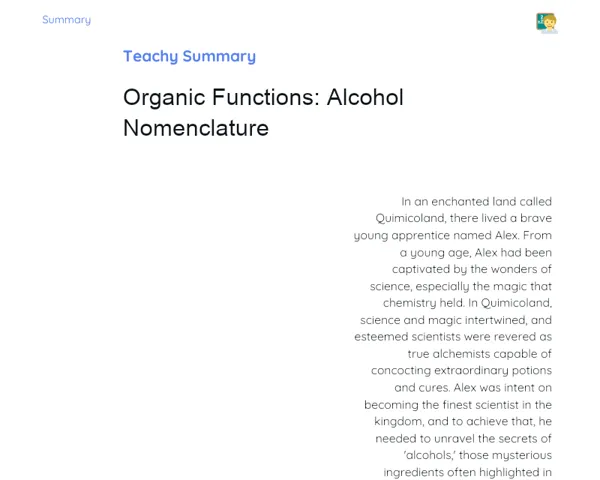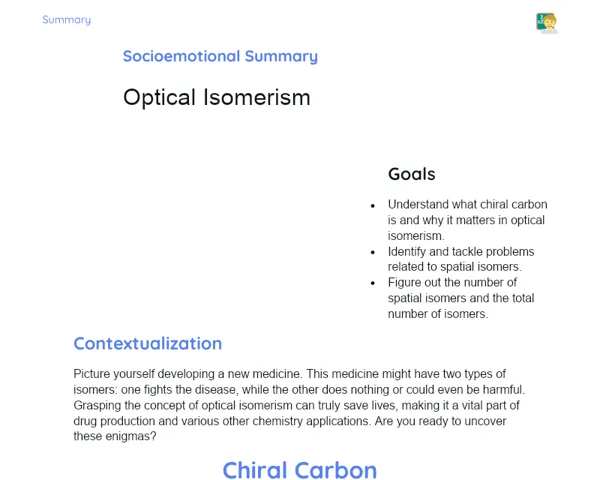Summary Tradisional | Introduction to Organic Chemistry: Chain Classification
Contextualization
Organic Chemistry is that part of chemistry that focuses on carbon compounds, which are vital for life and prominent in our everyday experiences. From our food to the medicines we rely on, many substances around us are organic compounds. This field of study is key to understanding the structure, properties, and reactions of these compounds, leading to major advancements in science and industry.
Classifying carbon chains is a foundational aspect of Organic Chemistry, as it helps in the identification and organization of compounds based on their structures. Carbon chains can be open or closed, saturated or unsaturated, homogeneous or heterogeneous, among other classifications. Grasping these categories is crucial for a detailed understanding of organic compounds and their practical uses, including the creation of new materials, drugs, and fuels.
To Remember!
Open Chains (or Acyclic)
Open chains are those that don’t form rings. They can either be linear, where all the carbon atoms line up in a straight line, or branched, which means they've got side chains (carbon atoms that aren’t part of the main chain). A common example of an open chain is butane (C₄H₁₀), which can exist in both linear and branched forms.
Open chains are essential in organic chemistry because many straightforward organic compounds, like aliphatic hydrocarbons, exhibit this structure. The difference between linear and branched chains matters as it impacts the physical and chemical properties of the compounds, including melting points, boiling points, and reactivity.
Additionally, the saturation state of open chains is a vital consideration. Saturated chains only have single bonds between carbon atoms, while unsaturated chains feature one or more double or triple bonds. This distinction greatly affects the reactivity and characteristics of the compounds.
-
Do not form rings.
-
Can be linear or branched.
-
Saturation affects physical and chemical properties.
Closed Chains (or Cyclic)
Closed chains, or cyclic chains, are those in which carbon atoms create a ring. They can be alicyclic when the ring consists solely of carbon atoms, or aromatic when the ring shows resonance, like with benzene. Cyclohexane serves as an example of a closed alicyclic chain, while benzene represents a classic aromatic chain.
Cyclic chains hold significant importance in organic chemistry because of their unique properties. Aromatic compounds, in particular, are recognized for their stability and specific reactivity due to the resonance in the benzene ring. This makes these compounds highly valued in the chemical and pharmaceutical industries.
The categorisation of cyclic chains also considers the presence of heteroatoms in the ring, such as oxygen, nitrogen, or sulfur, creating heterocyclic compounds. These are crucial in biochemistry and drug development.
-
Form a ring of carbon atoms.
-
Can be alicyclic or aromatic.
-
May include heteroatoms, forming heterocyclic rings.
Homogeneous and Heterogeneous Chains
Homogeneous chains are made up entirely of carbon atoms in the main chain. These compounds are quite common and include many basic hydrocarbons. A familiar example is octane, which is a homogeneous and saturated chain found in petrol.
In contrast, heterogeneous chains feature different atoms, such as oxygen, nitrogen, or sulfur, within the main chain. These heteroatoms introduce various functionalities into the molecules, changing their properties and reactivity. For instance, ethanol (C₂H₅OH) contains an oxygen atom in its main chain, giving it polar characteristics and enabling hydrogen bond formation.
The presence of heteroatoms is crucial in medicinal chemistry and biochemistry, as many biological compounds, like amino acids and nucleotides, have heterogeneous chains. These compounds are vital for biological functions and the creation of complex materials.
-
Homogeneous: all atoms in the main chain are carbon.
-
Heterogeneous: contain atoms different from carbon in the main chain.
-
Heteroatoms alter properties and reactivity.
Saturated and Unsaturated Chains
Saturated chains have only single bonds between carbon atoms. These compounds, often referred to as alkanes, tend to be less reactive and have higher melting and boiling points than their unsaturated peers. Methane (CH₄) is a well-known example of a simple saturated compound.
Unsaturated chains, conversely, feature one or more double or triple bonds between carbon atoms. These additional bonds make the molecules more reactive, allowing them to participate readily in chemical reactions, including addition and polymerization. Ethylene (C₂H₄), which contains a double bond, is a prime example of an unsaturated compound.
Unsaturation is significant in organic chemistry because it greatly influences the physical and chemical characteristics of compounds. Double and triple bonds introduce rigidity and planarity to molecules, affecting their three-dimensional structure and reactivity. Unsaturated compounds are extensively used in the production of plastics, synthetic rubbers, and other polymeric materials.
-
Saturated: only single bonds between carbon atoms.
-
Unsaturated: one or more double or triple bonds.
-
Unsaturation heightens reactivity and influences physical properties.
Key Terms
-
Open Chains (or Acyclic): Chains that don’t form rings, can be linear or branched.
-
Closed Chains (or Cyclic): Chains that form rings, can be alicyclic or aromatic.
-
Homogeneous Chains: Chains where all atoms are carbon.
-
Heterogeneous Chains: Chains containing atoms other than carbon.
-
Saturated Chains: Chains with only single bonds between carbon atoms.
-
Unsaturated Chains: Chains with one or more double or triple bonds between carbon atoms.
Important Conclusions
In this lesson, we covered the classification of carbon chains in Organic Chemistry, a vital topic for grasping the structure and properties of organic compounds. We explored both open (or acyclic) and closed (or cyclic) chains, noting the distinctions between linear, branched, alicyclic, and aromatic types. We also highlighted the significance of homogeneous and heterogeneous chains, as well as the differences between saturated and unsaturated chains.
The ability to classify carbon chains is foundational for identifying and understanding organic compounds, with practical implications in the chemical, pharmaceutical, and materials science sectors. A solid understanding of these classifications allows us to anticipate the physical and chemical behaviours of compounds, facilitating advancements in creating new materials and medications.
We encourage students to keep delving into the subject, as the insights gained are crucial for progressing in more complex studies of Organic Chemistry and grasping the chemistry of the compounds that surround us in our daily lives. Continuous practice and review of concepts are essential for solidifying learning.
Study Tips
-
Review the key concepts about carbon chains and their classifications, using diagrams and practical examples for better visualization of the structures.
-
Work through exercises and questions on the classification of carbon chains to bolster your learning and clarify any uncertainties.
-
Check out supplementary materials, such as educational videos and scientific articles, to deepen your understanding of the significance and applications of the various classifications of carbon chains.



